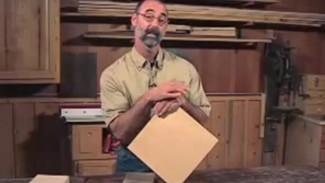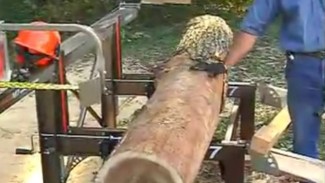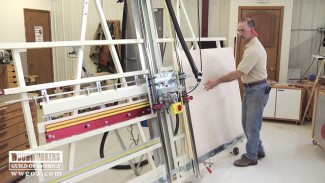Looking for a great project that you can put together in no time? In this free video lesson, we teach you step by step how to build a side table. The joinery is simple, with screw pockets holding everything together.
Getting Started: How to Build a Side Table
Prep your material by jointing straight edges onto all your parts. This is especially important on pieces you’ll be gluing edge to edge for the top and shelf. Cut one end square on your rails and legs. Cut them to their final length.
Joinery
We’re using screw pockets throughout the project. Drill pocket holes in the back face of one of the mating boards for each edge to edge joint. Also drill pocket holes in both edges of each rail.
Allow for Expansion and Contraction
Follow the instructions for using your pocket hole jig to create elongated holes in the top edge of the short rails. This allows us to screw the rails to the top and shelf while still allowing the parts to move seasonally.
Assembly
Before assembly use a ⅛” roundover bit on all the outside corners. Use a ¼” spacer to provide the correct reveal between the legs and rails, and a 3-½” long spacer to position the lower rails.
Cut the top and shelf to their final sizes and install them on the base. When finishing the project it’s best to remove the top and shelf so you can get finish on both faces, then reinstall them.
Cut List
Top ¾” x 16” x 25-½”
Long rails ¾” x 2-½” x 21-½”
Short rails ¾” x 2-½” x 11-½”
Legs 1-½” x 1-½” x 28”
Shelf ¾” x 14-½” x 24-½”
More Info
For more information on Kreg products visit their website or give them a call at (800) 447-8638.





you had me until “pocket holes”
How does he know how far away from the long sided edge to drill the pocket holes?
Rodger,
The idea is to constrain as little of the wood movement as possible, while still securing the top solidly. So he’s choosing the optimal trade-off between solid mounting of the top and minimal constraint wood movement.
Paul
Woodworkers Guild of America
Did you use any glue when you attached the top and the shelf to the assembly or did you just use the screws? Thanks
Hey Dennis!
Our expert, Paul has some more info for you:
Just screws alone are used here. Glue is avoided due to the cross grain joinery that would occur if glue was used. The wood needs the ability to expand and contract with seasonal humidity fluctuations.
Paul
Thanks!
Madeline
Woodworkers Guild of America Video Membership
I bought red cedar spindles for legs. Frame is cedar. Top is grenadillo.
My better-half really likes the look of this table, but wants to mount a granite top and paint the base black. I know the top will need to be glued to the base with polyurethane adhesive. Any suggestions on wood selection for the base (legs and rails)? Seems to be a waste (and expensive) to use a nice tight grained hardwood only to finish with paint.
Hello. That sounds like a nice way to dress up this piece. For a painted base I would recommend whatever closed grain hardwood you can find at a good price. I use poplar a lot for pained projects, as it is readily available in my area, relatively low cost, and takes a paint finish beautifully. Maple would be a great choice too if you can find it for a good price.
Thanks
Paul
Woodworkers Guild of America
Love it! Any plans I can print out?
Hello John!
There aren’t any plans to print but there are directions located underneath the video. I have also included them in this comment:
GETTING STARTED: HOW TO BUILD A SIDE TABLE
Prep your material by jointing straight edges onto all your parts. This is especially important on pieces you’ll be gluing edge to edge for the top and shelf. Cut one end square on your rails and legs. Cut them to their final length.
JOINERY
We’re using screw pockets throughout the project. Drill pocket holes in the back face of one of the mating boards for each edge to edge joint. Also drill pocket holes in both edges of each rail.
ALLOW FOR EXPANSION AND CONTRACTION
Follow the instructions for using your pocket hole jig to create elongated holes in the top edge of the short rails. This allows us to screw the rails to the top and shelf while still allowing the parts to move seasonally.
ASSEMBLY
Before assembly use a ⅛” roundover bit on all the outside corners. Use a ¼” spacer to provide the correct reveal between the legs and rails, and a 3-½” long spacer to position the lower rails.
Cut the top and shelf to their final sizes and install them on the base. When finishing the project it’s best to remove the top and shelf so you can get finish on both faces, then reinstall them.
CUT LIST
Top ¾” x 16” x 25-½”
Long rails ¾” x 2-½” x 21-½”
Short rails ¾” x 2-½” x 11-½”
Legs 1-½” x 1-½” x 28”
Shelf ¾” x 14-½” x 24-½”
If you have any other questions, please let us know via email (wwgoasubscription@program-director.net), chat, or by calling us at 1-855-253-0822.
Sincerely,
Jessica
Woodworkers Guild of America Video Membership
What woods would be good for this table?
Hello. Any hardwood would be a good choice; oak, maple, cherry, walnut, etc.
Thanks
Paul-Woodworkers Guild of America